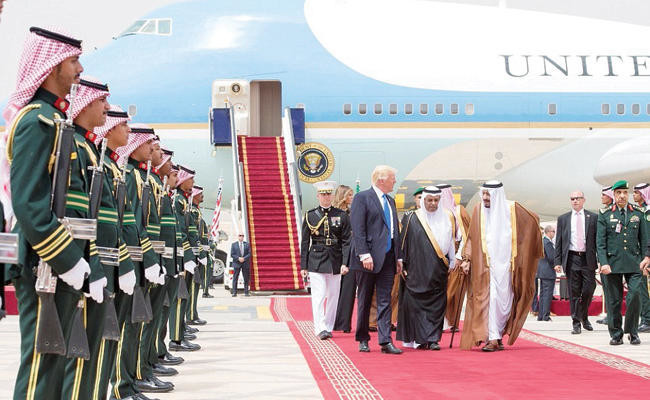LONDON: Washington’s warm welcome for Saudi Crown Prince Mohammed bin Salman has cast a rosy glow over the US and Saudi Arabia’s “strong relationship’’ and looks likely to raise US President Donald Trump’s standing in the Kingdom still further, say analysts.
Deals struck during the trip are expected to deepen the ties developed during Trump’s first year in office, building on the positive reception he received during his visit to Saudi Arabia in May last year.
“Even frank conversations … about hard topics are unlikely to dampen the strong relationship between the two countries,” said Becca Wasser, a Middle East policy analyst at the US think tank Rand.
While the red carpet rolled out for the crown prince has not quite matched the “glitz and glamor” of Trump’s Riyadh reception, there has been no shortage of friendly overtures from the White House.
Trump’s trip last year prompted a surge in support for the US president in the Kingdom, with 57 percent of participants saying the visit had strengthened US-Saudi ties, while 23 percent said they would vote for Trump if given the chance, according to a YouGov survey.
The study revealed a 15-point increase in support compared with a previous poll conducted by YouGov and Arab News in October 2016, when only 8 percent of Saudis said they would choose Trump as US president.
“There is no doubting that the popularity of President Trump in Saudi Arabia is significant. This is exactly why Mohammed bin Salman headed to Washington to reinforce his plans for Vision 2030,” said Andrew Campbell, managing director of Brand Finance Middle East.
“In our Brand Finance Nation Brands report, Saudi Arabia ranked as the 22nd most valuable brand globally and it is precisely this global influence that the Trump administration is looking to leverage,” he said.
Riding on the back of a rewarding trip to London earlier this month, the crown prince was looking to “mirror that same success in the United States,” Wasser said.
Saudi officials see greater accord with team Trump than with previous administrations, observers said.
“Among policymakers, (Trump) has been welcomed as a clear change from his predecessor, and someone whose background as a larger-than-life real estate developer they could much more easily relate to, unlike President Obama, where there was no personal chemistry or mutual understanding,” said Kristian Coates Ulrichsen, Middle East Fellow at Rice University’s Baker Institute.
Since taking office, the US president has won over many in the Kingdom, who see him as a “firm supporter of Saudi Arabia” and an ally on “critical issues of mutual interest,” said Gerald Feierstein, director for Gulf affairs and government relations at the Middle East Institute.
“Saudi Arabia has been eager to show it is open for business and that includes attracting more US investment — in line with broader goals to increase FDI share in GDP enshrined in Vision 2030,” said Maya Senussi, senior Middle East economist at Oxford Economics.
Strategic challenges in the region, particularly Iran, have also featured in the latest talks. The US and Saudi Arabia remain broadly aligned on the challenges posed by the Iranian regime and the need to curtail its widening reach across the Middle East.
However, the Trump administration has so far failed to follow through on its tough talk over Iran and the nuclear deal remains in place. The US has also disappointed Saudi expectations over its response to the Qatar boycott. Trump’s tweets initially endorsed Saudi Arabia’s position, but US approval for firmer action has since been withheld.
The US president’s tendency to detour on policy positions has put many Middle East governments on their guard, Ulrichsen said. While Saudi officials had “high hopes” when Trump took office, his record since has been “somewhat underwhelming.”
Dr. Christopher Davidson, Middle East politics professor at Durham University, said the Saudi perspective on Trump was “very wary,” although the recent ousting of Rex Tillerson — an unpopular figure in the Kingdom — as US secretary of state would have scored well with many in Saudi Arabia.
“The issues are perhaps more with the rest of US government rather than necessarily Trump himself. I would say with the firing of Rex Tillerson, one of the stumbling blocks is gone,” Senussi said.
“Like other countries, Saudi Arabia has struggled to keep pace with some of the changes in the Trump administration during its first year as well as contradictory statements from senior members of the administration. Such discrepancies are concerning for US partners, such as Saudi Arabia, and difficult for them to manage,” said Wasser.
However, she said the administration’s “unwavering support” for Saudi policies, in particular the reform program being rolled out by the crown prince, holds true and “undoubtedly shapes the view of President Trump from Riyadh.”


Trump rolls out the red carpet for ‘firm ally’
Trump rolls out the red carpet for ‘firm ally’

Saudi King Salman receives message from Russian president

- The two officials reviewed strong relations between Saudi Arabia and Russia
RIYADH: King Salman received a written message from Russian President Vladmir Putin regarding ties between the two countries.
Russian Ambassador to the Kingdom Sergey Kozlov delivered the message to Saudi Deputy Foreign Minister Waleed Elkhereiji in Riyadh, the Foreign Ministry wrote in a post on X on Tuesday.
The two officials reviewed strong relations between Saudi Arabia and Russia and discussed the latest regional and international developments, as well as the efforts made in this regard.
© 2025 SAUDI RESEARCH & PUBLISHING COMPANY, All Rights Reserved And subject to Terms of Use Agreement.














